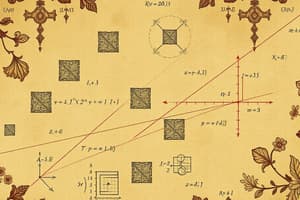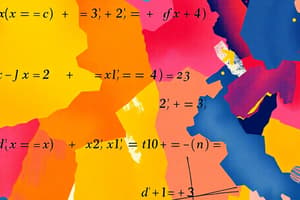Podcast
Questions and Answers
Solving the equation $2(x - 2) = 8$ results in $x = 8$.
Solving the equation $2(x - 2) = 8$ results in $x = 8$.
False (B)
In the equation $7(x + 4) = 2(5x - 4)$, if solved correctly, the solution will yield $x = 6$.
In the equation $7(x + 4) = 2(5x - 4)$, if solved correctly, the solution will yield $x = 6$.
True (A)
The solution to the equation $-99x = 33$ is $x = -
rac{1}{3}$.
The solution to the equation $-99x = 33$ is $x = - rac{1}{3}$.
False (B)
In the equation $32/5 x + 16x/5 + 4/5 = 10$, the value of $x$ when solved is $x = 2$.
In the equation $32/5 x + 16x/5 + 4/5 = 10$, the value of $x$ when solved is $x = 2$.
The equation $4(x - 3) = 4(3x + 1)$ simplifies to $x = -
rac{3}{5}$.
The equation $4(x - 3) = 4(3x + 1)$ simplifies to $x = - rac{3}{5}$.
Flashcards
Balancing method
Balancing method
To solve a linear equation using the balancing method, we perform operations on both sides of the equation to isolate the variable on one side. The goal is to maintain the equality of the equation throughout the process. For example, if we add a number to one side, we must add the same number to the other side to preserve the balance. This method is based on the idea of keeping both sides of the equation equivalent by performing the same operations on both sides.
Linear equation in one variable
Linear equation in one variable
A linear equation in one variable is an algebraic equation where the highest power of the variable is 1. It can be written in the form ax + b = 0, where a and b are constants and a is not equal to 0. Solving a linear equation means finding the value of the unknown variable (x in this case) that makes the equation true.
Verification of a solution
Verification of a solution
Verification of a solution involves substituting the value of the variable obtained from the solved equation back into the original equation. If the left-hand side of the equation becomes equal to the right-hand side after substituting the value, then the solution is verified. It confirms that the value we found is indeed a correct solution for the equation.
Solving equations with fractions
Solving equations with fractions
Signup and view all the flashcards
Simplifying an algebraic equation
Simplifying an algebraic equation
Signup and view all the flashcards
Study Notes
Solving Linear Equations
-
Method 1: Balancing Method
- Solve for 'x' by performing the same operation on both sides of the equation to isolate 'x'.
- Important: Operations include addition, subtraction, multiplication, or division.
-
Method 2: Transposition Method
- Isolate the variable term on one side of the equation by moving the constant terms to the opposite side.
- Change the signs of the terms during transposition.
- This helps in solving equations step-by-step.
Example Problems (Using Balancing Method)
-
Problem a) 32x + 8x + 2 = -10
- Combining like terms: 40x + 2 = -10
- Subtract 2 from both sides: 40x = -12
- Divide both sides by 40: x = -12/40 which simplifies to x = -3/10
-
Problem d) 32x + 16x/4 = 10
- Simplify fraction: 32x + 4x = 10
- Combine like terms: 36x = 10
- Divide both sides by 36: x = 10/36 which simplifies to x = 5/18
-
Problem g) 0.34x + 2.4 = 6.5x
- Isolate x terms on one side by subtracing 0.34x from both sides: 2.4 = 6.16x
- Divide by 6.16 on both sides: x = 24/616 = 0.39
Example Problems (Using Transposition Method)
-
Problem j) 7 + 4(3x-1) = 2x - 3
- Distribute the 4: 7 + 12x - 4 = 2x - 3
- Combine like terms: 3 + 12x = 2x - 3
- Subtract 2x from both sides: 3 + 10x = -3
- Subtract 3 from both sides: 10x = -6
- Divide both sides by 10: x = -6/10 which simplifies to x = -3/5
-
Problem k) 7x - 5x - 0.3 = 2.1/6
- Combine like terms: 2x - 0.3 = 0.35
- Add 0.3 to both sides: 2x = 0.65
- Divide both sides by 2: x = 0.325
-
Problem c) 2(x-2) = 8
- Distribute the 2: 2x - 4 = 8
- Add 4 to both sides: 2x = 12
- Divide both sides by 2: x = 6
-
Problem e) 2 - 11x = 5x - 4
- Add 11x to both sides: 2 = 16x - 4
- Add 4 to both sides: 6 = 16x
- Divide both sides by 16: x = 6/16 = 3/8
Verification steps
- Substitute the calculated value of 'x' back into the original equation.
- Simplify both sides and if the equation holds true, verified your solution.
Studying That Suits You
Use AI to generate personalized quizzes and flashcards to suit your learning preferences.




